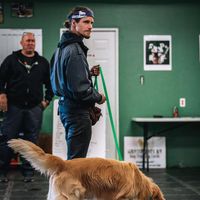Jan 20 (edited) in Blog Posts
How To Fit Training Into Your Busy Schedule
Today we are going to solve a common problem, one often made worse by training classes and professional trainers! How do you train your dog while having a busy schedule? The truth is it is much easier, and often better for your dog to skip the marathon training sessions and just make use of small moments throughout the day.
The Myth of Lengthy Sessions:
First off, let’s clarify something. Just because you go to group training, or your trainer charges by the hour does not mean that training sessions should be an hour long. In fact, I believe it should be quite the opposite. Ideally training sessions are not longer than your dog’s attention span, and there is nothing wrong with a quick training session thrown in whenever you have the time. Often times clients will try to replicate their last group class as their practice but they end up making training tedious and too drawn out for both them and their dogs. Keep most of your sessions short, frequent, and highly engaging. As far as planned-out training sessions go, 90% of mine are 5-10 minutes.
Seizing Micro-Moments:
Find micro-moments to seize. Practice sending your dog to Place while your coffee brews, practice Heel around the living room while your partner decides on a movie, Recall your dog from across the house, throw a belly rub party, and then move on with your life. You don’t need to carve out hours of time to train your dog.
Incorporating into Daily Routines:
One of the best ways to make sure you are training every day is by using your training daily. During your regularly scheduled walk, you can practice the things that take more time like working on how long your dog can stay in heel. I always recommend working on Place duration while watching TV or while eating dinner. One of the most powerful moments is in the 5 minutes before a meal. Use the food they are going to get anyway and work on some high-energy obedience, they’re hypermotivated anyway, so use it without adding significant time to your routines. The more you can integrate training into your day, the stronger these patterns become and the more usable they will be.
Quality Over Quantity:
Knowing when to end a training session will help as well. Quality repetitions create good patterns, as soon as that quality breaks down you’ve already made a mistake. I can’t even begin to count the number of training sessions I have cut short because of how well the dog did. That’s right, I cut training short when the dog is right at their peak, not after. Two minutes in is fine, I just want the dog’s last memory of that session to be when he did the command with precision and passion. That’s when I’ll rain kibble from the sky and call it done.
Maintaining Consistency:
Consistency is key, I’m not the first to say this nor the last but that’s because it is true. I would rather you work with your dog for 10 minutes every day than 1 hour twice a week when you’ve finally found time. This is so often the difference between successful and unsuccessful clients, training is a part of their everyday life with their dog.
In dog training, less can often mean more. Embrace short, focused training moments and integrate them into your daily routine. The beauty lies in the simplicity – training becomes a part of your life, not an added chore. So make the most of your valuable time and make your training more efficient at the same time.
0
0 comments

skool.com/the-k9-classroom-4030
Providing free dog training information. Improving the lives of both owners and their dogs through education.
powered by
